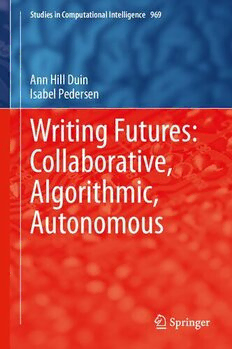
Wrting Futures: Collaborative, Algorithmic, Autonomous PDF
Preview Wrting Futures: Collaborative, Algorithmic, Autonomous
Studies in Computational Intelligence 969 Ann Hill Duin Isabel Pedersen Writing Futures: Collaborative, Algorithmic, Autonomous Studies in Computational Intelligence Volume 969 SeriesEditor JanuszKacprzyk,PolishAcademyofSciences,Warsaw,Poland The series “Studies in Computational Intelligence” (SCI) publishes new develop- mentsandadvancesinthevariousareasofcomputationalintelligence—quicklyand withahighquality.Theintentistocoverthetheory,applications,anddesignmethods of computational intelligence, as embedded in the fields of engineering, computer science, physics and life sciences, as well as the methodologies behind them. The series contains monographs, lecture notes and edited volumes in computational intelligence spanning the areas of neural networks, connectionist systems, genetic algorithms,evolutionarycomputation,artificialintelligence,cellularautomata,self- organizingsystems,softcomputing,fuzzysystems,andhybridintelligentsystems. Ofparticularvaluetoboththecontributorsandthereadershiparetheshortpublica- tiontimeframeandtheworld-widedistribution,whichenablebothwideandrapid disseminationofresearchoutput. IndexedbySCOPUS,DBLP,WTIFrankfurteG,zbMATH,SCImago. AllbookspublishedintheseriesaresubmittedforconsiderationinWebofScience. Moreinformationaboutthisseriesathttp://www.springer.com/series/7092 · Ann Hill Duin Isabel Pedersen Writing Futures: Collaborative, Algorithmic, Autonomous AnnHillDuin IsabelPedersen DepartmentofWritingStudies FacultyofSocialScienceandHumanities UniversityofMinnesota OntarioTechUniversity Minneapolis,MN,USA Oshawa,ON,Canada ISSN1860-949X ISSN1860-9503 (electronic) StudiesinComputationalIntelligence ISBN978-3-030-70927-3 ISBN978-3-030-70928-0 (eBook) https://doi.org/10.1007/978-3-030-70928-0 ©TheEditor(s)(ifapplicable)andTheAuthor(s),underexclusivelicensetoSpringerNature SwitzerlandAG2021 Thisworkissubjecttocopyright.AllrightsaresolelyandexclusivelylicensedbythePublisher,whether thewholeorpartofthematerialisconcerned,specificallytherightsoftranslation,reprinting,reuse ofillustrations,recitation,broadcasting,reproductiononmicrofilmsorinanyotherphysicalway,and transmissionorinformationstorageandretrieval,electronicadaptation,computersoftware,orbysimilar ordissimilarmethodologynowknownorhereafterdeveloped. Theuseofgeneraldescriptivenames,registerednames,trademarks,servicemarks,etc.inthispublication doesnotimply,evenintheabsenceofaspecificstatement,thatsuchnamesareexemptfromtherelevant protectivelawsandregulationsandthereforefreeforgeneraluse. Thepublisher,theauthorsandtheeditorsaresafetoassumethattheadviceandinformationinthisbook arebelievedtobetrueandaccurateatthedateofpublication.Neitherthepublishernortheauthorsor theeditorsgiveawarranty,expressedorimplied,withrespecttothematerialcontainedhereinorforany errorsoromissionsthatmayhavebeenmade.Thepublisherremainsneutralwithregardtojurisdictional claimsinpublishedmapsandinstitutionalaffiliations. ThisSpringerimprintispublishedbytheregisteredcompanySpringerNatureSwitzerlandAG Theregisteredcompanyaddressis:Gewerbestrasse11,6330Cham,Switzerland Acknowledgments ThedevelopmentofWritingFutureswasneverasolitaryexperience.Wewerelucky enoughtobesurrounded(virtuallyandphysically)bycolleagues,students,family, andfriendswhoconstantlyinspiredusovertheseasonsittooktocreateit. WearegratefulfortheworkofSharonCaldwell,whoseexpertise,creativity,and steadfastattentiontodetailhelpedusbuildourarchivedcollectionandintegrateit withbookchaptersintrulyskillfulways.WeoweourgraciousthankstoMollyM. Kessler,Lee-AnnKastmanBreuch,andLauraGurak,whoeachselflesslyhelpedin very important ways. We thank James Harbeck, with his insightful and fastidious copyedit. Our Springer editors and production team, Thomas Ditzinger, Gowris- hankar Ayyasamy, and Sylvia Schneider, were immensely helpful while we wrote and prepared the manuscript. We thank our blind reviewers for their time, energy, and direction on the book. Developer Seth Kaufman from Whirl-i-Gig Inc. made somecliffhangerdeadlinesformuch-neededchangestotheFabricdatabaseinlight ofthebook’sdesign. WearehonoredforthecollaborationoftheIntertextauthors,HeidiA.McKeeand James E. Porter, Jennifer Keating and Illah Nourbakhsh, and Scott Sundvall, who probed and provoked the book’s themes in myriad novel ways. It is stronger with theirvoices. Weextendourthankstoouracademiccollaboratorsandfriends,whosewisdom, camaraderie,andscholarshipexhilaratedus,includingJasonTham,DanielHocutt, AndrewIliadis,TomEverrett,PeterTurk,TannerMirrlees,JaydenCooper,andJack AdamNarine.Weacknowledgetheimportantroleofourstudents:AnnHillDuin’s graduateclassattheUniversityofMinnesota,scholarsMikaylaDavis,SeanGolden, BrianLeLay,ShaneRose,andRiraZamani,willingtoshareopinions,raisedebates, and question the future landscape of writing studies through their distinct schol- arlylenses.ThestudentsofIsabelPedersen’scomputersciencegraduatecourseat OntarioTechUniversity,GlobalAIEthicsbroughttheirowninsightstobearonmany debated topics surrounding the emergence of AI during the writing of the book. Another group that influenced our thinking and writing was the Building Digital Literacy team, including graduate students Katlynne Davis, Saveena (Chakrika) Veeramoothoo,andDanielleStambler;scholarsandprofessorsJasonTham,Daniel Hocutt,JessicaCampbell,StephenFonash,LauraGonzales,JohnMisak,andNupoor v vi Acknowledgments Ranade,whointegratedFabricofDigitalLifeincourseworkoverthreephasesofan eighteen-monthstudy.Theseengagingscholarsfromdiversebackgrounds(compo- sition,rhetoric,technicalcommunication,education)metregularly,sharedinstruc- tionalmaterials,andwroteresearchpaperstogether.Wearegladtohavecollaborated inthisongoingdialogovertheconceptofdigitalliteracy. Wethankallthefuturistswhoinspireusdaily,andwebothmarvelandshudderat thespeedwithwhichtheirpredictionsbecomerealityincollaborative,algorithmic, andautonomouswritingfutures. We thank our families for allowing us the time and space to muse over writing futuresandtoaspiretocreateaframeworkforpreparingforwritingfuturesinadvance ofmajortechnologicaltransformations.Wethankeachotherforatrulyremarkable collaborativeexperience. Last,weacknowledgethatthisresearchwasundertaken,inpart,thankstofunding fromtheCanadaResearchChairsprogramandfromtheUSCouncilforPrograms inTechnicalandScientificCommunication. Contents 1 WritingFuturesFramework ..................................... 1 1.1 Introduction ............................................... 1 1.2 IntegrationwithFabricofDigitalLife ......................... 2 1.3 TracingtheFutureofWriting ................................ 5 1.4 PastStudies,FutureSpeculation .............................. 10 1.5 TheWritingFuturesFramework .............................. 13 1.6 OverviewofChapters ....................................... 15 References ..................................................... 20 Intertext—TheFutureofWritingandRhetoric:PitchbyPitch byScottSundvall,TheUniversityofMemphis ...................... 23 2 CollaborativeWritingFutures ................................... 27 2.1 HowWillWritersCollaborate? ............................... 27 2.1.1 FoundationalScholarshiponCollaboration .............. 29 2.1.2 Socio-technologicalConstructionofKnowledge .......... 30 2.1.3 CollaborativeWorkspaces ............................. 35 2.2 What Digital Literacies Will Writers Need to Enable Constructive,CollaborativeWorkwithNonhumanAgents? ....... 37 2.3 WhatCivicChallengesDemandCollaborative,Constructive SocialActionThroughandwithNonhumanAgents? ............ 41 References ..................................................... 43 Intertext—Writing Machines and Rhetoric by Heidi McKee andJamesPorter,MiamiUniversity ................................ 47 3 AlgorithmicWritingFutures .................................... 53 3.1 HowWillAlgorithmsandAIInformWriting? .................. 53 3.1.1 UnderstandingAlgorithms ............................ 54 3.1.2 PlatformStudies ..................................... 57 3.1.3 Demographics ....................................... 59 3.1.4 AlgorithmicAI ...................................... 60 3.2 WhatAILiteraciesShouldWeCultivateforAlgorithmic WritingFutures? ........................................... 62 vii viii Contents 3.2.1 Learning Analytics and Learning Management Systems ............................................ 64 3.3 HowMightAIHelptoRecognize,Ameliorate,andAddress GlobalCivicChallenges? .................................... 71 3.3.1 Writing for Ethically Aligned Design, Moving fromPrinciplestoPractice ............................ 73 References ..................................................... 76 Intertext—RecodingRelationshipsbyJenniferKeating,University of Pittsburgh, and Illah Reza Nourbakhsh, Carnegie Mellon University ...................................................... 81 4 AutonomousWritingFutures .................................... 85 4.1 HowWillWritersWorkwithAutonomousAgents? ............. 85 4.1.1 TheRiseofVirtualAssistants .......................... 86 4.1.2 AIWriting .......................................... 91 4.1.3 CreativeAI ......................................... 96 4.2 HowWillLiteracyPracticesChangewithUseofAutonomous Agents? ................................................... 98 4.3 What Affordances of Autonomous Agents Lend ThemselvestoMoreEthical,Personal,Professional,Global, andPedagogicalDeployments? ............................... 100 4.3.1 FairnessandNon-discrimination ....................... 101 4.3.2 AIExplainabilityandTransparency ..................... 102 References ..................................................... 103 5 WritingFutures:Investigations .................................. 109 5.1 ImaginingtheFuture ........................................ 109 5.1.1 TrustandTechnologicalLeadership .................... 112 5.2 Methods/Methodologies/Approaches for Investigating andPlanningforWritingFutures ............................. 116 5.3 Academic,Industry,andCivicInvestigations ................... 123 5.3.1 AcademicRealm ..................................... 124 5.3.2 IndustryRealm ...................................... 127 5.3.3 CivicRealm ......................................... 130 5.4 ImaginingWritingFutures ................................... 134 References ..................................................... 136 AppendixA:Course Syllabus for a Graduate-Level Course, Writing Futures—Collaborative, Algorithmic, Autonomous .......................................... 141 AppendixB: Complete List of General Keywords in Writing FuturesCollectionwithCounts ......................... 155 About the Authors Dr.AnnHillDuin is Professor of Writing Studies and Graduate-Professional DistinguishedTeachingProfessorattheUniversityofMinnesotawhereherresearch and teaching focus on the impact of emerging technologies on digital literacy, analytics, collaboration, and writing futures. She is a founding member of the EmergingTechnologiesResearchCollaboratoryattheUniversityofMinnesota.She served15yearsinhighereducationadministrativerolesincludingViceProvostand AssociateVicePresidentforInformationTechnology.Herrecentscholarshipappears inComputersandComposition,CommunicationDesignQuarterly,IEEETransac- tions on Professional Communication, Technical Communication Quarterly, Plan- ning in Higher Education, Rhetoric and Professional Communication and Glob- alization, International Journal of Sociotechnology Knowledge Development, and Connexions:InternationalProfessionalCommunication.Herinternationalcollabo- rationincludesresearchclusterleadershipintheDigitalLifeInstituteatOntarioTech UniversityandongoingmentorshipofglobalvirtualteamsaspartofTrans-Atlantic PacificPartnershipinitiatives. Dr.IsabelPedersen isProfessorofCommunicationStudiesandCanadaResearch ChairinDigitalLife,Media,andCultureatOntarioTechUniversityintheFacultyof SocialScienceandHumanities.SheistheFounderandDirectoroftheDigitalLife Institute,whichhostsinternationalresearchpartnerships.Herresearchconcentrates onhowsocietaltransformationtoverypersonal,embodiedtechnologyisaffecting life,meaning-making,ethics,policy,politics,culture,andthearts.Sheteachesinthe graduateprograminComputerScience.SheisalsoanAssociateoftheJointGraduate PrograminCommunicationandCultureatRyersonUniversityandYorkUniversity. SheisCo-editorofEmbodiedComputing:Wearables,Implantables,Embeddables, Ingestibles (Pedersen and Iliadis 2020, MIT Press). She is published in academic journalsincludingtheJournalofInformation,CommunicationandEthicsinSociety, InternationalJournalofCulturalStudies,andtheJournalonComputingandCultural Heritage. ix
